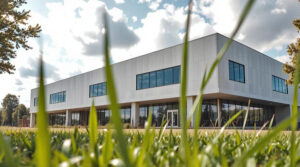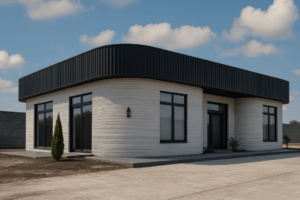
Where is the greatest potential for reducing carbon dioxide emissions, and which construction technologies can maximise the energy efficiency of buildings?
The construction and operation of buildings accounts for 39% of global CO2 emissions, of which 28% comes from operational emissions and the energy required for heating, cooling, and power supply, and 11% comes from the manufacture of materials and construction.
In the EU, only 25% of buildings are considered energy efficient, while in Ukraine the share of such buildings is about 5%. Consequently, the greatest potential for reducing carbon emissions lies in improving the energy efficiency of buildings and reducing the use of fossil fuels in the manufacture of building materials.
The use of energy-efficient building envelopes in combination with technologies such as heat pumps, renewable heat and electricity sources is the best way to create energy-independent buildings and achieve climate neutrality.
Rauta offers energy-efficient technologies using Ruukki products to create energy-efficient buildings.
Thanks to the special configuration of the joints and the presence of an EPDM seal in the sandwich panel locks, maximum airtightness of q50≤1 m3/(m2h) is achieved and energy consumption is reduced by up to 20% compared to conventional panels.
Highly efficient building envelopes made of Ruukki sandwich panels not only reduce overall carbon dioxide emissions and operating costs, but also provide greater comfort for people, enhance the company’s image, and increase the value of the building.
The use of Ruukki’s energy-efficient sandwich panels with special accessories and additional joint sealing can reduce a building’s energy consumption by up to 30%.
Green steel products
In 2023, Ruukki became the first company in the world to start producing sandwich panels and ventilated facade cladding from green steel, which is produced using hydrogen, electricity, and biogas instead of fossil fuels. The residual product of this production process is water, not carbon dioxide.
For facades and roofs that will be used in highly aggressive environments, Ruukki offers special Hiarc and Pural coatings, which provide excellent resistance to ultraviolet radiation, have increased resistance to dirt and scratches, and are also capable of reducing the heating temperature of the surface of enclosing structures.
Under the same conditions, energy-reflective coatings heat up 23% less than conventional coatings. This further reduces the amount of energy required to heat or cool rooms.
Rauta’s solution is a rooftop solar power plant that includes an enclosure made of Ruukki roof sandwich panels and modern monocrystalline solar panels with a set of special mounts.
Currently, the return on investment in RoofSolar for commercial buildings is 3.5-4 years.
Today, construction expertise is measured not in tons of concrete and steel, but in how little the construction and operation of buildings affect the environment. Improving construction technologies and using more energy-efficient materials and structures are essential steps for developers to take to preserve the planet.

Scientists from the Kyiv National University of Construction and Architecture (KNUCA), together with partners, have launched an international project to create new concrete mixtures using waste, in particular, destroyed structures, for construction using 3D printing and traditional methods, according to the KNUCA press service.
The release states that as part of the project “Development of new approaches and construction materials for the restoration of Ukraine’s damaged infrastructure with consideration for environmental sustainability,” researchers are developing a concrete mixture with the addition of materials resulting from the destruction of buildings and other industrial and agricultural waste.
The restoration of housing in Ukraine requires the introduction of universal technologies for rapid construction that allow for the construction of sustainable and affordable buildings even in conditions of limited resources. Due to the war, many buildings in Ukraine have been destroyed. The remains of concrete structures can be effectively recycled and used for the construction of new housing. Compared to traditional construction methods, 3D printing of buildings can ensure faster construction rates, significantly reduce human resource use, and save materials and energy.
The project is co-funded by the US Office of Naval Research and the US National Science Foundation (NSF). The research is being conducted as part of the multilateral partnership initiative “International Multilateral Partnership for Ensuring the Sustainability of the Education and Science System in Ukraine (IMPRESS-U), launched by the Office of International Science and Engineering (OISE) of the US National Science Foundation with the participation of researchers from Stony Brook University in the US and the Jan and Jędrzej Sniadecki University of Technology in Bydgoszcz, Poland.
The project will last two years.
At KNUBA, the implementation of this project has been entrusted to lecturers, postgraduate students, and students of the Faculty of Construction and Technology, in particular, the Department of Building Materials and the Department of Building Structures and Products Technology.

The Antimonopoly Committee of Ukraine (AMCU) has authorized Cliff Capital Growth Fund Vcic Ltd (Cyprus), a company associated with Kovalska ICG, to acquire a stake in Unit B04 LLC.
According to the committee’s decision of February 8, the Cypriot company received permission to acquire a stake that ensures exceeding 50% of the votes in Unit B04’s supreme management body.
Kovalska Group CEO Serhiy Pylypenko told Interfax-Ukraine that Kovalska Real Estate was the developer of B04.
“Now, by increasing our share in the property through a shareholder company, we intend to become the sole owner of this ultra-modern facility,” Pylypenko said.
According to Opendatabot, Cliff Capital Growth Fund Vcic Ltd currently owns 50% of the B04 building of the Unit.City innovation park. Another 50% is owned by Unit Holdings LLC, the ultimate beneficiary of which is businessman Vasyl Khmelnytsky.
As reported, the AMCU approved the acquisition of Kovalska’s stake in buildings B04 and B06 from Unit.City in 2021. The group planned to invest $70 million in the construction of five business centers in Unit.City – B01, B02, B03, B04, B06.
The Cliff Capital Growth investment fund is managed by Guardo Assets Management, which also manages the Aksioma, A Realty, AC Real, and Vingis funds.
Kovalska Industrial and Construction Group has been operating in the Ukrainian construction market since 1956. It unites more than 20 enterprises in the field of raw materials extraction, production and construction. Its products are represented by the brands Concrete by Kovalska, Avenue, and Siltek. Kovalska’s enterprises operate in Kyiv, Zhytomyr, Lviv, and Chernihiv regions. The aerated concrete plant in Kherson region has not been operating since the beginning of the occupation. The group also includes Kovalska Real Estate, which is engaged in the construction of residential properties in Kyiv. Its portfolio includes more than 20 completed residential projects.
Share of new buildings, in which construction was resumed, by regions of Ukraine

Source: Open4Business.com.ua and experts.news

The Cabinet of Ministers of Ukraine has adopted a resolution which introduced the procedure for extending the law “On guaranteeing the rights to real estate objects that will be built in the future”, the head of the party “Servants of the People”, MP Elena Shulyak said.
“Ukraine has created a legal mechanism for the state to guarantee the rights to objects of unfinished construction and future real estate. Our #5091 in action! “, – wrote Shulyak in Facebook.
Implementation of this law will protect people investing in the construction of apartments, from disadvantaged developers (which, in particular, is extremely important in the reconstruction of the country after the war). The developer who wants to sell the apartments, garage boxes, other residential and non-residential premises or parking spaces must necessarily register each of these objects as a special object of property rights in the section of the register of real rights. Also, the developer must disclose detailed information about the object of construction, data about himself and the ultimate beneficiaries.
“A transparent primary real estate market and restoration of trust in construction companies is our common small internal victory,” said Shulyak.
She specified to Interfax-Ukraine agency that the corresponding section of the register is expected to be launched on June, 16.
As it was reported, the president of Ukraine Volodymyr Zelenski signed the law “On guaranteeing property rights to real estate that will be built in the future” on September 8, 2022 to protect the rights of investors in new housing.
The corresponding bill #5091 was passed by the Verkhovna Rada on August 15.
Share of new buildings, in which construction was resumed, by regions of Ukraine in march 2023

Source: Open4Business.com.ua and experts.news